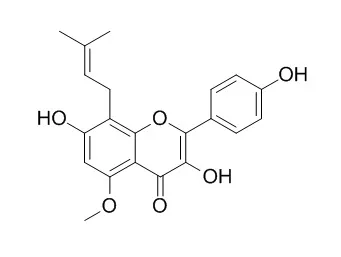| In vitro: |
| Arch Pharm Res. 2011 Dec;34(12):2087-99. | | Anti-tumorigenic activity of sophoflavescenol against Lewis lung carcinoma in vitro and in vivo.[Pubmed: 22210035] | This study examined the in vitro cytotoxic activity and in vivo antitumor activity as well as intracellular apoptotic capacities of a prenylated flavonol, Sophoflavescenol from Sophora flavescens, to evaluate prospective anti-tumorigenic drugs, and antitumor potential. In addition, the in vitro antioxidant and anti-inflammatory capacities were evaluated.
METHODS AND RESULTS:
Despite the small effect on human breast adenocarcinoma (MCF-7), Sophoflavescenol showed cytotoxicity against human leukaemia (HL-60), Lewis lung carcinoma (LLC), and human lung adenocarcinoma epithelial (A549) cells. Interestingly, it also exerted potent in vivo antitumor activity by tumor growth inhibition in the LLC tumor model as well as apoptotic activity by caspase-3 activation in HL-60 cells. In addition, it exhibited potent antioxidant activities in 1,1-diphenyl-2-picrylhydrazyl, 2,2'-azino-bis(3-ethylbenzothiazoline-6-sulfonic acid) diammonium salt radicals and lipid peroxidation assays. Sophoflavescenol exerted notable anti-inflammatory activity by inhibiting nitric oxide generation and tert-butylhydroperoxide-induced ROS generation rather than inhibiting nuclear factor kappa B activation in RAW 264.7 cells.
CONCLUSIONS:
The findings show that the antioxidant, anti-inflammatory, and apoptotic activities of Sophoflavescenol might contribute to the antitumor activity without severe side effects, highlighting its potential for chemoprevention and/or anticancer drugs due to multi-effective targets in almost all stages of tumorigenesis, including initiation, promotion, and progression. | | Bioorg Med Chem Lett. 2002 Sep 2;12(17):2313-6. | | A prenylated flavonol, sophoflavescenol: a potent and selective inhibitor of cGMP phosphodiesterase 5.[Pubmed: 12161123 ] | During the search for naturally occurring cyclic guanosine monophosphate (cGMP)-specific phosphodiesterase type 5 (PDE5) inhibitors, it was found that the extracts from Sophora flavescens exhibit potent inhibitory activity against cGMP PDE5 prepared from rat diaphragm.
METHODS AND RESULTS:
Therefore, the inhibitory activities of five flavonoids, kushenol H (1), kushenol K (2), kurarinol (3), Sophoflavescenol (4) and kuraridine (5), isolated from S. flavescens were measured against cGMP PDE5 to identify potent cGMP PDE5 inhibitory constituents. Among tested compounds, Sophoflavescenol (4), a C-8 prenylated flavonol, showed the most potent inhibitory activity (IC(50)=0.013 microM) against cGMP PDE5 with 31.5- and 196.2-fold selectivity over PDE3 and PDE4, respectively.
CONCLUSIONS:
Kinetic analysis revealed that Sophoflavescenol was a mixed inhibitor of PDE5 with a K(i) value of 0.005 microM. |
|






 Cell. 2018 Jan 11;172(1-2):249-261.e12. doi: 10.1016/j.cell.2017.12.019.IF=36.216(2019)
Cell. 2018 Jan 11;172(1-2):249-261.e12. doi: 10.1016/j.cell.2017.12.019.IF=36.216(2019) Cell Metab. 2020 Mar 3;31(3):534-548.e5. doi: 10.1016/j.cmet.2020.01.002.IF=22.415(2019)
Cell Metab. 2020 Mar 3;31(3):534-548.e5. doi: 10.1016/j.cmet.2020.01.002.IF=22.415(2019) Mol Cell. 2017 Nov 16;68(4):673-685.e6. doi: 10.1016/j.molcel.2017.10.022.IF=14.548(2019)
Mol Cell. 2017 Nov 16;68(4):673-685.e6. doi: 10.1016/j.molcel.2017.10.022.IF=14.548(2019)